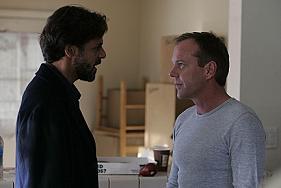Who would guess that the Sundance Film Festival would offer not one, but two compelling stories of life inside Russian Orthodox monasteries? “The Island” is a dark, foreboding, but ultimately transcendent film set on an icy Russian setting. “The Monastery: Mr. Vig and the Nun” is a Danish documentary filled with eccentric humor and profound beauty. I caught both films on the same packed day of Sundance screenings.
 Director Pernille Rose Gronkjaer invested five years (and her own money) chronicling Mr. Vig’s 50-year effort to transform his Danish castle into a monastery. A former Lutheran pastor, Mr. Vig wants “to create something enduring, something of quality.” As a student of world religions, Mr. Vig had initially tried to establish a Buddhist monastery on his Hesbjerg estate. But when Sister Amvrosya and a team of Russian Orthodox nuns come to inspect the castle, it is out with the Thangkas, in with the Icons. This is the first of a series of comedic clashes between the monkish Mr. Vig and the determined Sister Amvrosya. Mr. Vig must fix the heater and repair the roof before the nuns will embrace Hesbjerg as their new home. The nuns bring a literal warmth to Vig’s dilapidated castle.
Director Pernille Rose Gronkjaer invested five years (and her own money) chronicling Mr. Vig’s 50-year effort to transform his Danish castle into a monastery. A former Lutheran pastor, Mr. Vig wants “to create something enduring, something of quality.” As a student of world religions, Mr. Vig had initially tried to establish a Buddhist monastery on his Hesbjerg estate. But when Sister Amvrosya and a team of Russian Orthodox nuns come to inspect the castle, it is out with the Thangkas, in with the Icons. This is the first of a series of comedic clashes between the monkish Mr. Vig and the determined Sister Amvrosya. Mr. Vig must fix the heater and repair the roof before the nuns will embrace Hesbjerg as their new home. The nuns bring a literal warmth to Vig’s dilapidated castle.
As the story evolves, the filmmaker Pernille Rose Gronkjaer, also enters the drama, asking telling questions to Mr. Vig about his love life. He has practiced poverty and chastity, but clearly he struggles with obedience to rigors of the Orthodox Church. In an exclusive audio interview, Gronkjaer talked to students from the WindRider Forum about the fairy tale elements of the story.
With his imposing beard and furry hats, Mr. Vig looks like a character straight out of a Hans Christian Anderson story. The beauty of the Danish countryside is contrasted with the crumbling castle. Gronkjaer salutes the persistence of Mr. Vig and Sister Amvrosya as they overcome the elements and their personality clash to create a rare and humane love story. By the time Mother Amvosya leads Mr. Vig in a procession around the property, there wasn’t a dry eye in the theater.
 “The Island” (Russian title, “Ostrov”) also follows a long procession, from cowardly acts in World War II, to profound moments of contemporary healing. Under pressure from the Nazis, a young sailor, Anatoli, shoots his ship captain, Tikhon. Washing ashore on a remote Russian island, Anatoli is rescued by Orthodox monks. Thirty years later, Anatoli has become a revered holy man, working out his salvation by digging coal and stoking fires for the monastery. Father Anatoli has become a source of prophecy, healing, and hope. Despite his spiritual power, Anatoli veers along the edge of madness, still haunted by his dark past. He walks “The Island,” begging for forgiveness.
“The Island” (Russian title, “Ostrov”) also follows a long procession, from cowardly acts in World War II, to profound moments of contemporary healing. Under pressure from the Nazis, a young sailor, Anatoli, shoots his ship captain, Tikhon. Washing ashore on a remote Russian island, Anatoli is rescued by Orthodox monks. Thirty years later, Anatoli has become a revered holy man, working out his salvation by digging coal and stoking fires for the monastery. Father Anatoli has become a source of prophecy, healing, and hope. Despite his spiritual power, Anatoli veers along the edge of madness, still haunted by his dark past. He walks “The Island,” begging for forgiveness.
Building upon the celebrated legacy of Russian director Andrei Tarkovsky, filmmaker Pavel Lounguine has crafted a classic story of redemption. Anatoli pushes the Russian Orthodox priests to purge themselves of material goods and distractions. Lounguine comments upon post-communist Russia and its uncritical embrace of commerce. Anatoli also performs an exorcism with nothing but a simple prayer and the sign of the cross. It is a memorable moment of pure, transcendental cinema. But will Anatoli find rest for his weary soul? “The Island” offers haunting answers to his fervent prayers. Amidst a dark and dreary setting, “The Island” concludes with a symbol of eternal hope–a slow, dramatic fade to white.
–Posted by Craig Detweiler
Screenwriter Craig Detweiler directs the Reel Spirituality Institute (www.reelspirituality.org) at Fuller Seminary.


